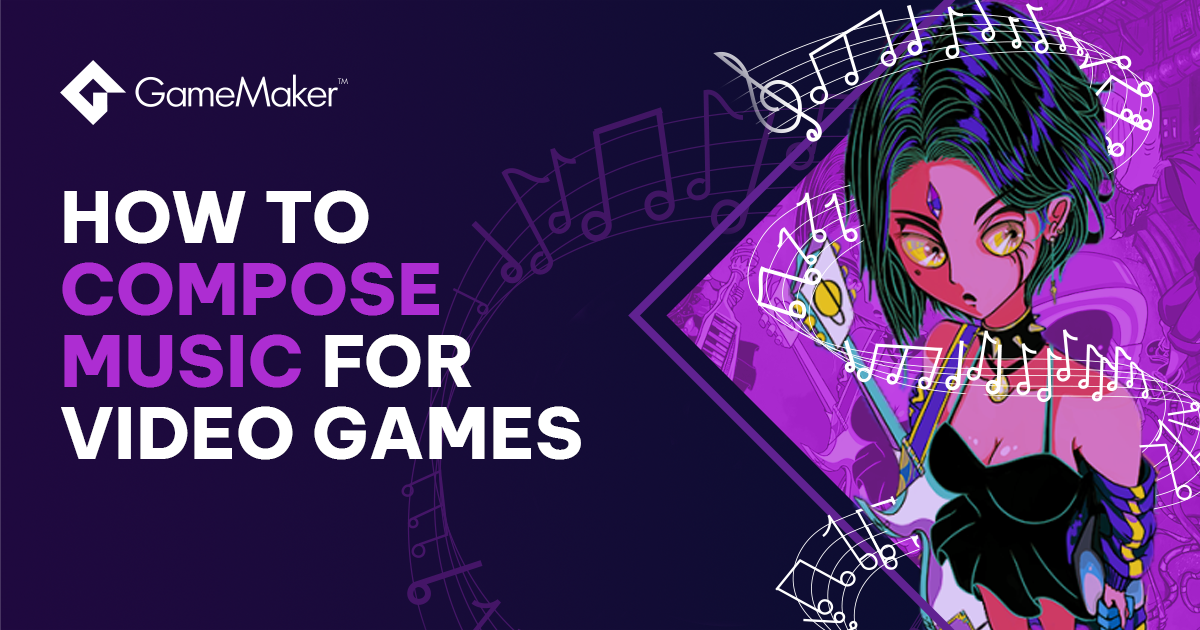Whether you enjoy finger dancing to a rhythm game or soul-searching to a synthesiser symphony (try saying that three times fast), video game music is fundamental to your experience.
But what makes video game composition a unique field, and how do you compose interactive music for games?
Bastion, developed by Supergiant Games, award-winning composition by Darren Korb
What’s The Difference Between Composing For Video Games And Visual Media?
The biggest difference between composing music for video games and other visual media is that games are non-linear and interactive.
Consider the journey of the player throughout a game: where are they? Where will they be next? Will they come back to this part of the map when there are zombies crawling all over it?
You need to design a complex system that allows your music to react to each situation but doesn’t distract from the gameplay.
In both mediums, however, there are the same priorities of sounds:
- Dialogue, which has to be clear and be heard over all other in-game noise
- Sound effects, which immerse players in the game's world
- Music composition, which sets the tone of the game and its levels
Disasterpeace, the video game composer of a GameMaker hit Hyper Light Drifter, spoke in detail about the philosophy of game music in Fez. (His interview includes spoilers, so here’s your warning).
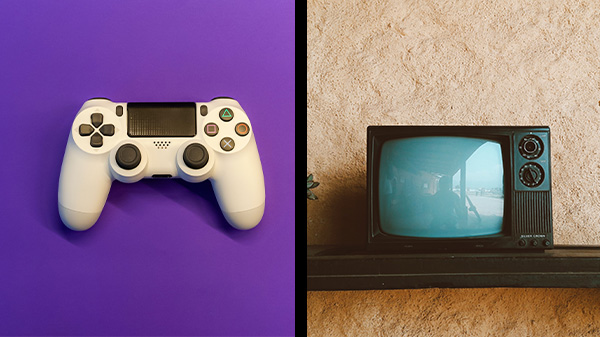
Source: Unsplash
What Is Interactive Music?
Remember the 1978 game Space Invaders?
The tempo of the music speeds up the closer the aliens get to you, standing your hair on end as you enter your own Red Dead-esque deadeye mode. This technique is known as interactive music - where the music changes according to the gameplay.
There are two different ways of composing interactive music: vertical remixing and horizontal re-sequencing.
Space Invaders (1978), music and development by Tomohiro Nishikado
What Is Vertical Remixing?
Vertical remixing is a sort of modular approach to composing: creating layers of seamless music loops that work by themselves and can play together.
Each layer is given an intensity level:
Layer one - Low-intensity (perhaps a slow melody?)
Layer two - Medium intensity (maybe some hand percussion?)
Layer three - High intensity (how about a gritty lead synth line?)
Layer four - Special instance (possibly a musical sting)
An in-game value is given to an area or enemies in the game. This trigger controls a parameter, which in turn determines the volume of each layer so that the music seamlessly changes during the gameplay.
Perhaps you’re wandering around a magical forest and hear a slow-developing flute melody (layer one). Then, you discover a hidden treasure and a violin accompanies the flute in a crescendo (layer four). AH! CRAP! You can hear a robotron enemy destroying the forest. The drums begin (layer two).
This type of layer-based adaptive music is called vertical remixing and is used in games from Red Dead Redemption to Pokémon Sword and Shield.
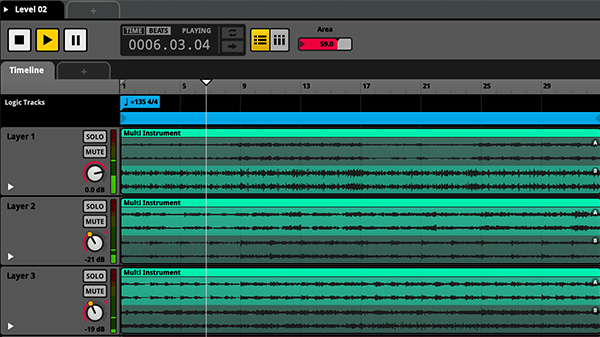
An FMOD project (see later in the article) using vertical remixing. The area parameter (red, top middle) is mapped to triggers in the game, it changes the volume of each layer.
Challenges Of Using Vertical Remixing
This interactive music technique can be tricky to implement well in some games.
For example: if the action is changing quickly, the sound might constantly move between each layer. If you have a longer game where the same layering system is used throughout, it can become flat as a Goomba.
You can get around this by combining vertical remixing and horizontal re-sequencing.
What Is Horizontal Re-Sequencing?
Horizontal re-sequencing is when you create loopable sections, rather than specific instrumental layers. Each section can quickly and smoothly transition to any other when needed.
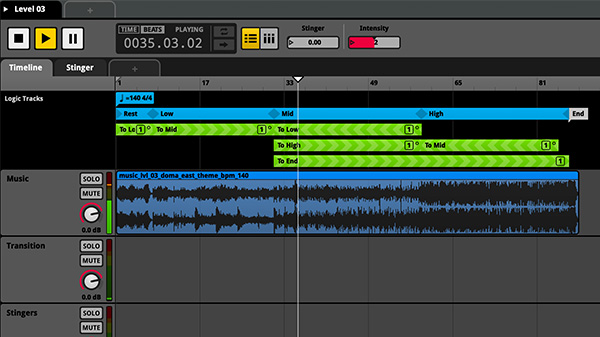
An FMOD project using horizontal re-sequencing. The intensity parameter (red, top middle) is mapped to triggers in the game, it changes the section of audio playing in the game.
Winifred Philips, the composer of titles such as God of War, Assassin's Creed III Liberation, and Little Big Planet breaks down horizontal re-sequencing in a two-part video.
Challenges With Horizontal Resequencing
Most music is built in a 4/4 time signature. This means that there are four beats in every bar. A bar is like a container that holds a number of beats for a certain time. Music usually changes at the start of the next bar - beat five - to sound as natural as possible.
However, video game music is dynamic: some changes need to happen at a moment's notice. For example, the music might need to change on beat three rather than beat five. This can make this shift in sound less than satisfying.
To get around this problem, you can create clever transitions with risers, faders, and effects.

Friday Night Funkin’ is a popular online free rhythm game, completed for Ludum Dare Game Jam 41
Making Music Fun, Always And Forever
To keep your game sounding fresh, combine both styles and create a hybrid. Use vertical remixing within each horizontal re-sequencing group, so your music can change as the game progresses.
Claude Ruelle, the composer of My Time at Sandrock, gives a thorough explanation of adaptive music with some visual examples.
Game Audio Implementation Software
When you’re learning how to compose music for video games, FMOD and Wwise are surfboards among the waves: they take a little while to master, but once you get it, you’re scooting atop the choppy waters, looking pretty cool.
These software are called ‘middleware’, and they make it easier for you to compose interactive music without needing to understand coding and - more importantly - without having to sacrifice control to programmers.
FMOD has been specifically designed to look like a digital audio workstation (DAW), so it’s very intuitive if you’re familiar with one. Wwise is less intuitive but more powerful.
Wwise is often preferred by AAA studios and FMOD is often used in indie titles since FMOD is free for games on a small development budget, but Wwise isn't free for any commercial project.
If you’re using GameMaker, it has been announced that FMOD will be supported in 2023.
For more, sound designer Mike Lane does a video series comparing the different software, and you can learn how to use middleware in one of their official courses:
- Wwise free courses with accreditation
- FMOD YouTube tutorials
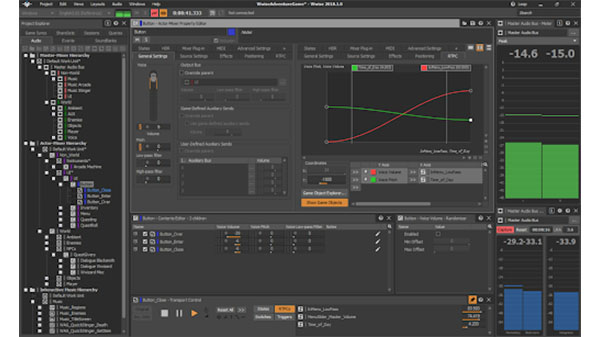
Wwise User interface, source: Audiokennic
Tips On How To Compose Music For Video Games
The following are some tricks of the trade to answer any questions and to get your compositions sounding professional.
How To Choose What Instruments To Use
If you’re making a game about cowboys, think about what instruments might put your audience in a western mood.
In the Wild West, you’re more likely to find a banjo than a synthesiser, so build your soundtrack with instruments that make sense within the context of the story.
Tell A Story With Sound
Consider your character’s journey and how to tell it through your music. The relaxed melody your gunslinger whistles when they’re alone could be mimicked with strings and trumpets during the final shoot-out.
Listen to the compositions in Red Dead Redemption 2: the music reflects the context.
Red Dead Redemption 2, developed by Rockstar Games
Test Out Different Music Before You Start
It’s common for video game composers to try out different music over the gameplay before they start composing. This can give you direction and can help you identify which instruments you like and why.
It can also create a coherent vision with the game designer. However, be careful to tell the designer that your music will have similar features, but will be essentially different from the test.
Compare Your Music At The End
After you’ve finished composing, compare your song to another that you know sounds good. Where does your music need more or less?
A published song will have been professionally mixed and mastered. This makes a huge difference, so don’t judge yourself too harshly.
Audio Mixing In Video Games
Imagine there’s a moment in your game where a bomb detonates close by, just as a mighty monster howls to the sky. Your soundtrack is absolutely popping off to magnify the chaos enveloping the player - but all that noise is probably going to create some audio distortion or kill clarity.
You need to make sure your game doesn’t feature too many sound effects and musical notes playing in the same frequency range at any one time, to keep things sounding smooth.
FMOD and Wwise have tools such as a virtual mixing desk to help with this challenge. You can also limit the amount of sound which plays at any time or use sidechaining to prioritise different sounds.
Listen to the compositions in Little Nightmares II. Less is often more.
Little Nightmares II, developed by Tarsier Studios, composer Tobias Lilja
What Sound File Types Are Better For Games?
It’s good practice to use a file type that saves space and CPU. There are many compressed file types, such as mp3 and OGG, and if you’re making a game for a Playdate device, you may need to use WAV with (and take a breath before you tackle this acronym) IMA ADPCM encoding. It can feel like a minefield.
More often than not, the game designer or programmer will tell you what they need. Otherwise, .wav and .aiff files can be pretty large, so try switching to OGG files, these compress the file by 10x.
Paolo Nicolello once took a picture of a confused monkey: we can exclusively reveal that IMA ADPCM encoding was what confused the wee munchkin.
A confused monkey, by Paolo Nicolello
What Is A Good DAW For Game Music?
DAW stands for Digital Audio Workstation, and it’s vital for composing game music. In a DAW, you can record sounds onto your computer or you can use it as an instrument and manipulate sound digitally.
There’s not really a ‘best’ audio workstation - it’s more about what you do with them. Here are some options:
- GarageBand (Free for Mac)
- Cakewalk (Free for PC)
- Audiotool (Free, browser-based)
- Reaper (Excels at SFX)
- Ableton (Excels at idea generation)
- Logic (Good allrounder, Mac only)
- Nuendo (Excels at SFX and implementation)
- Cubase Pro (Excels at composing)
- Pro Tools (Excels at post-production)
Often you can get the best results with more than one programme: one to generate ideas, and another for post-production and exporting. We’d recommend downloading each DAW’s free trial to determine which one suits your needs the most.
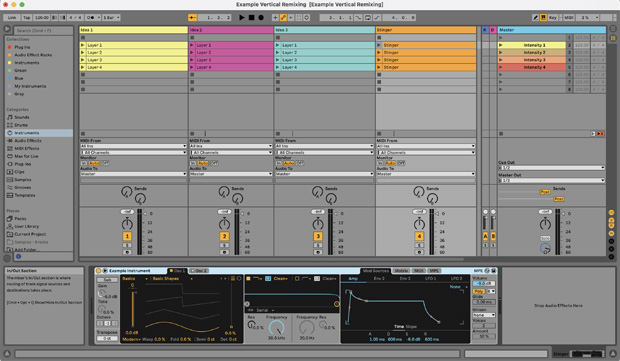
Ableton’s ‘session view’: a useful tool for demoing vertical remixing
Plugins For Composers
If you like Disasterpeace, and you are composing 8-bit adventures, you can do so using instruments that come with your DAW, your own hardware, or you can download a plugin synth, such as:
- Free Synths
- Massive X (check out Disasterpeace’s musical workshop)
- Serum (STRANJAH does a series of tutorials in SERUM)
If you want to compose an orchestral piece at industry standards, it’ll cost a fair bit. You can download sample instruments from providers, such as:
- Free plugins
- Kontakt Komplete (gives you a bit of everything, including Massive X)
- Spitfire Audio (a specialist and a great choice)
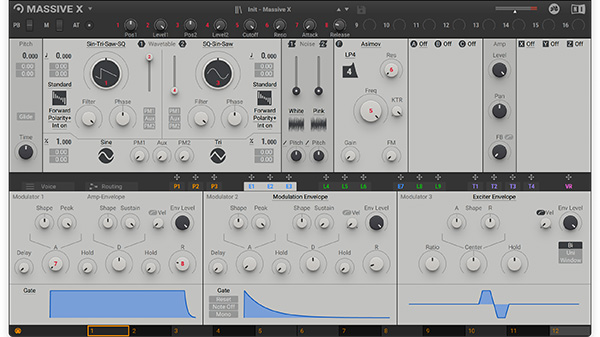
Massive X - the big brother of the synthesiser Disasterpeace uses to compose.
What Game Engine Should You Use?
Of course, you can’t create a game without a game engine. Learning how to implement sound in specific game engines is a useful skill and may help you land a job.
There are many to choose from, and like DAWs, each has its own benefits. We’ve written an extensive guide to the best indie game-making software to help you decide which best suits your project.
If you’re pressed for development time (as you would be in a game jam, for instance), it’s not always possible to link middleware (FMOD, Wwise) to your game engine, so it’s useful to learn how to use audio in your software of choice.
This doesn’t always require a deep knowledge of code - just time familiarising yourself with the software.

Hyper Light Drifter, Developed by Heart Machine, music composed by Disasterpeace, created in GameMaker
How To Start Composing Video Game Music
To start composing, familiarise yourself with a DAW and create your own soundtracks.
Next, game jams are a great way to get your head around middleware or a particular piece of game software. You make a game in three days and have to finish your song or you’ll let the team down.
Once you’ve got going, developing your knowledge is key.
Art of Composing is a great blog for general tips and Blipsounds has a free course on Reaper, FMOD, and Wwise.
Winifred Philips, a composer with more project credits than Sega has game releases, wrote a book called ‘A Composer’s Guide to Game Music’ which comes highly recommended by industry professionals.
Another great place to learn how to compose music for video games is GameSoundCon, featuring lectures from active sound designers and composers. Lessons can be attended remotely.
Discord is an excellent place for you to build a network of friends in the field. For composers and sound designers, there are some communities which hold friendly competitions and offer advice, such as:
Finding Video Game Composition Jobs
Finding work as a game composer comes from networking, proven skills, and more networking.
In the industry, AAA game studios hire whole teams to compose and create their soundtracks. In indie game development, teams are much smaller, and it's fairly common for a composer to also act as a sound designer and audio implementer.
Play an active role in the community whilst building up your own credibility, and create a video reel and a website where you showcase your skills.
Dev Brada has a ton of video game composing jobs that are regularly updated.
To help you price yourself - and explain your pricing - check out this article on budgeting for game audio.
How To Become A Game Composer With GameMaker
We mentioned the importance of specialising in a single game engine earlier.
GameMaker is a completely free game engine for beginners and professionals alike, specialising in the creation of 2D games. The software has been used to develop well-known indie games such as Undertale, Hotline Miami, and the BAFTA award-winning Chicory: A Colorful Tale.
If you want to have a go making a game our Hero’s Trail tutorial takes 30 minutes and after you can share it with your friends. Also, the GameMaker Forum is always there if you have any game-making questions.
If you’re using GameMaker, check out these important pages in the manual:
Don’t forget that FMOD support for GameMaker is scheduled for release in 2023.
We’d like to leave you with a soundtrack from the award-winning composer of Chicory: A Colorful Tale, Lena Raine.
Lena did an interview with GameMaker for our Women in Games week about her delve into game design, and she also talked to us about working on Chicory and Celeste if you want to check that out too.

